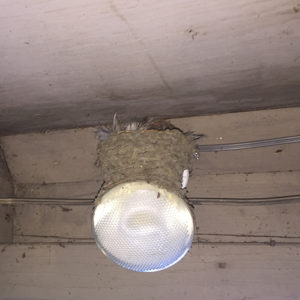 Bird nesting season began a few weeks ago. It’s been an exciting time here in our yard. We have five bird houses in various locations, as well as three nests built directly on our house.
Bird nesting season began a few weeks ago. It’s been an exciting time here in our yard. We have five bird houses in various locations, as well as three nests built directly on our house.
One of them is the nest in this photo, built on a light bulb in our carport. At first, Greg and I couldn’t figure out what was going on with the light bulb – why there was dirt piling up on it? But then, a day or so later, we saw two birds flying back and forth between the shore of our lake and the roof of the house. Believe it or not, they were flying so close that we could see the mud in their beaks!
When we realized what was happening, we jumped up to look at the light bulb in the carport. Sure enough, we realized they were building a nest.
This seemed like a big project for two little birds and I was impressed with how deliberate and industrious they were. As we observed more closely, we realized they chose wisely; it was a spot where no animals could climb up and rob it; they found mud from the lake shore and twigs from the front yard; they were clearly in a hurry to get it done.
These two birdies clearly know something about project management.
Here are three simple actions they took that can also make a big difference in the success of your project implementation, no matter what the size.
- Scope it out. Before starting a project, it’s important to get clear on what problem you’re trying to solve. Be as narrow as possible and write it down. If you’re working with others on the project, make sure everyone knows the expectations. It’s important the team knows not only what you’re doing, but why. This information will help them be better decision makers regarding their contribution.
- Assemble your resources. Take time to think about who you’ll need to help complete your project. Is this something you can do yourself or will you need to bring in experts to help with implementation? Know what the financial investment is before you commit and, periodically at planned intervals, check your expenses against your budget to make sure there are no surprises at the end.
- Set milestones and a target completion date. Make sure to break the project down in a way that makes sense to you and in a way to track progress. If you’re organizing your contact database, for example, decide how many contacts you’ll review in a week or day. If you’re building a website, set your milestones in project phases. The design will be completed by X, the content written by Y, the website launched on Z.When you’re tracking your milestones, also check to make sure you’re still within the scope of your project. Sometimes the scope needs to be adjusted. Make sure this happens as a result of a deliberate decision.
Like my birdie friends, who now have a beautiful home in our carport, sometimes getting things done just means follow some clear, simple steps.

 For the last seven years, my daughter Emily has been spending her summers at Pony Farm in New Hampshire. The first five years she was a camper and the last two she’s a Counselor in Training (CIT).
For the last seven years, my daughter Emily has been spending her summers at Pony Farm in New Hampshire. The first five years she was a camper and the last two she’s a Counselor in Training (CIT).